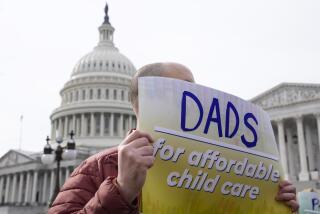SOUTHERN CALIFORNIA JOB MARKET: WORK AND FAMILY : 3 O’CLOCK SYNDROME : Firms offering aid for the after-school problem
- Share via
It is a scene repeated daily in countless offices and factories across the country. Anxious parents watch the clock and, minutes after the ringing of distant school bells, phone home to check up on their small fry.
Sound familiar? Call it the “3 o’clock syndrome”--when work is suspended and phone lines are jammed as working moms and dads seek reassurance that little Johnny or Jill made it home without incident and is not skateboarding through the living room or digging up the back yard with the heirloom Christofle silverware.
The influx of women into the work force and the rise in single parents have dramatically increased the number of children left to their own devices for a few hours in the afternoon, child-care experts say. Although reliable data is tough to come by, one survey suggests that at least 3.5 million children under age 13 care for themselves for a time during a typical week, and some contend that the figure is much higher.
With after-school child-care programs tough to find or prohibitively expensive, many parents say they have no choice. Increasingly, though, forward-thinking companies are lending a hand to employees.
In a 1991 survey of “Best Companies for Working Mothers,” New York-based Working Mother magazine found a variety of companies--including Apple Computer, Hewlett-Packard and Arco in California--that offer flexible work hours, provide on-site child-care centers or fund community programs.
“It’s a different answer for every employer,” said Marie Lipari of Hewitt Associates, an Illinois-based benefits consultant that offers flexible work schedules and a program of reimbursing child-care costs to parents who have to travel on business or work overtime.
Some employers have gotten wind of child-care troubles in strange ways. Several years ago, Whirlpool Corp., the home appliance maker, noticed an increasing number of calls from children to its toll-free assistance lines. As it turned out, many of the calls were from youngsters at home alone who needed help operating appliances.
In 1987, the Whirlpool Foundation donated $763,000 to establish Project Home Safe. Housed in the Alexandria, Va., offices of the American Home Economics Assn., the project advises parents and companies, funds research and offers training to volunteer home economists who then help implement after-school programs in their communities.
Pacific Bell, based in San Francisco, found in a 1990 survey that employees viewed care for school-age children as a top problem. Workers said frequent calls from unsupervised children at home were distracting them from their work, said Emily Bassman, the company’s human resources manager.
In January, the phone company announced plans to award grants to expand school-age child-care programs at schools and YMCAs in Anaheim, Pasadena, San Diego and other California cities. The cost to parents ranges from about $30 per week per child.
The “3 o’clock syndrome” is scarcely reserved for children of the working poor, as was the case in the 1800s, when house keys on neck chains were the badge of “latchkey children” on their own.
“It’s really a middle-class phenomenon,” said Sandra Hofferth, senior research associate at the Urban Institute, a nonprofit research group in Washington.
Surveys in some cities suggest that 30% to 70% of children aged 8 and over are “pretty unsupervised” for at least part of the day, according to Michelle Seligson, director of Wellesley College’s Center for Research on Women.
Come summer, the center expects to issue a study, funded by the U.S. Department of Education, that will document the number of before-school and after-school child-care programs and the number of participants. Seligson’s early estimate is that no more than 1.5 million children--a small percentage--are enrolled in official programs.
Many children who seem physically up to the task of caring for themselves “are asked to do more than they can do psychologically and emotionally,” Seligson said. In 1989, she noted, researchers at USC found that children left to fend for themselves for more than 10 hours a week were more likely than supervised children to smoke, drink and have sex at an early age.
But Hyman Rodman, a professor of human development and family studies at the University of North Carolina in Greensboro, contends that any ill effects of “self-care” on young children might be overstated. “Many parents now making decisions . . . have a pretty good handle” on their children’s abilities, he said, especially “once you’re dealing with children aged 9 or 10.”
Marty Uribes, a single mother who is a reporter for television station KRON in San Francisco, can attest to the difficult logistics involved with caring for a child when erratic work hours intervene.
“My concerns aren’t just at 3 o’clock,” Uribes said. “They’re at 6, 8 and 10 if I’m not home. It’s a real concern around the clock.”
She has often trusted her daughter Felicia, 9, to let herself in to the house while Uribes is at work. Uribes said she feels fairly relaxed about the situation because of their big yellow Labrador. Felicia, Uribes said, regards self-care “almost as a reward for maturity.”
But there have been a couple of times when Uribes panicked after calling the house and getting no answer at 3:45 p.m. After a few such scares, Uribes said, “I hired a live-in.”
More to Read
Inside the business of entertainment
The Wide Shot brings you news, analysis and insights on everything from streaming wars to production — and what it all means for the future.
You may occasionally receive promotional content from the Los Angeles Times.











